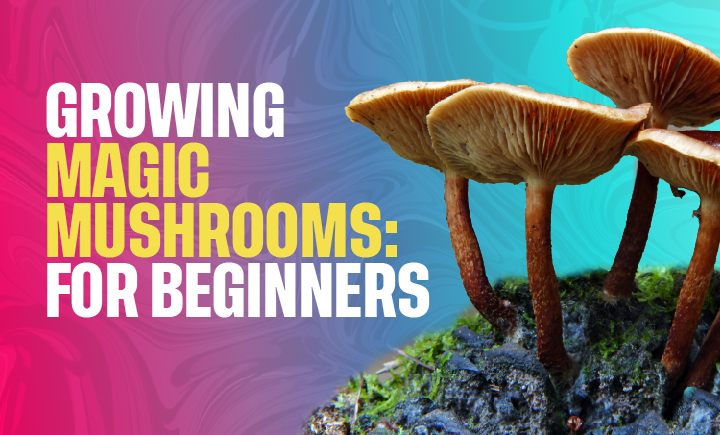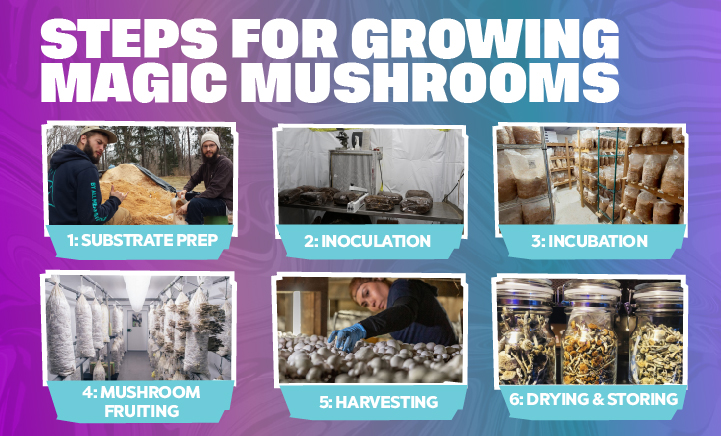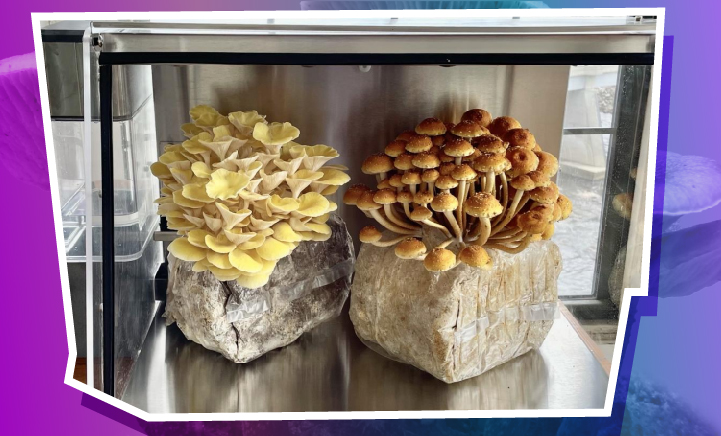Growing Magic Mushrooms: A Beginners Guide
- Magic Mushrooms
-
Sep 29
- Share post

A mushroom trip from ingesting psilocybin mushrooms or magic mushrooms makes for a fun psychedelic experience. You may have feelings of euphoria, a positive shift in your insight about your surroundings, and even an improvement in your mood and mental health.
If you’ve been a fan of shrooms for a long time, you know that quality fungi are the bomb but that they can also be quite pricey. It is for this reason that many are now choosing to grow their own shrooms so they can have a reliable supply of their beloved psychedelic fungi right in their own backyard. For many growers, it’s also a fun hobby that doesn’t cost a lot of money. Growing your own magic mushrooms is also safer than picking mushrooms in nature, where you risk ingesting the poisonous kinds.
Here, we’ll explore how you can get started on DIY mushroom cultivation so you can begin growing your own!
What You Need To Start Growing Magic Mushrooms
So you’ve decided to grow magic mushrooms at home. The good thing is that the process is pretty straightforward and easy, plus you have this guide to help you do it successfully. We’ll start with the materials you need to get started.
Spore syringe –
this one of the most important parts of magic mushroom cultivation. A spore syringe is simply a syringe that contains millions of mushroom spores and sterilized water and is utilized for the inoculation of the substrate. A spore syringe is perfect for novice growers due to its ease of use.
Drinking water –
this will need to be sterilized later in the process. Hydrating the spores are important because it prevents them from getting too dry that they’re unable to germinate.
Organic brown rice flour –
also known as BRF, is a popular substrate that can be mixed with vermiculite to grow different mushroom species, including psilocybin mushrooms.
Vermiculite – a mica mineral that is added to the substrate to help retain moisture and provide nutrients that will allow the shrooms to grow bigger.
Equipment:
12 shoulderless inoculation jars
Tin foil
Large mixing bowl
Nail and hammer
Strainer
Towels
Micropore tape
Spray bottle
Large pot
Perlite
Drill
A clear plastic storage box
Sanitation supplies
Air sanitizer
Latex gloves
70% isopropyl alcohol
Best Magic Mushroom Spores (And Where To Buy Them)
Now that you know all the essential components to start your mushroom cultivation journey, you may be wondering where to best source the ingredients you need, especially the most crucial one: mushroom spores. Don’t worry, and we will save you the hassle of going through hundreds of reviews online to find the best mushroom spores. Here are your best choices that we’ve vetted and recommend:
All You Need To Know About Cultivating Magic Mushrooms
You’re almost ready to grow your own magic mushrooms, so let’s now dive into the specifics, including the timeline for growing them, as well as the terms you’ll most likely encounter as you get into the world of cultivation.
Magic Mushroom Cultivation Terms
Substrate –
This serves as the mycelium’s source of food as well as the medium in which the mycelium can grow. The substrate for mushrooms should be properly prepared because the mushroom cannot grow and produce fruit without a good substrate. The substrate will then undergo additional processing, such as inoculation, sterilization, pasteurization, and incubation.
Inoculation –
This is the process wherein the desired organism is introduced into its growing environment. This can be done by injecting the spore into the substrate using a syringe. Making sure that everything is sterilized before introducing the spore to the substrate is important in this process.
Mycelium –
The fungi’s underground body is made up of millions of tiny threads. The mycelium searches the ground for organic material that will serve as a food source. When it locates a food source, it secretes an enzyme that causes the food to be broken down into smaller pieces. Mycelium can also be used for bioremediation and environmental restoration. Mycelium transforms biomasses into compost that can be used to grow food rather than simply going to waste.
Sterilization –
The process of sterilization involves subjecting the substrate to pressure and heating it to temperatures exceeding 250 degrees Fahrenheit in an effort to completely eradicate any dormant or active contaminants from the substrate. Sterilization is preferable to pasteurization for materials that are more nutrient-dense, like hardwood sawdust that have been supplemented. Before the mushrooms have a chance to fully colonize, the substrate will almost always become contaminated with mold if it is not sterilized.
Pasteurization –
The process of pasteurization involves heating a substrate to between 150 and 180 degrees Fahrenheit. Even though it may not be able to get rid of all the impurities, it will lower the overall number of other microbes to a point where the mushroom species has a better chance of surviving. Some microorganisms will endure pasteurization and continue to exist in the substrate to some capacity, but they will eventually prove beneficial for the mushroom’s development.
Incubation –
The majority of the magic mushroom cultivation process is spent in the incubation stage. The process can take up to 2 weeks. In this stage, the ideal conditions for magic mushrooms to grow at this stage must be created. These include the proper levels of humidity, temperature, light, and airflow.
Fruiting Chamber –
The vessel used to encourage mushroom growth or, fruiting bodies. A fruiting chamber should be a transparent container with some openings for light and airflow as well as high humidity levels. You can easily create the ideal conditions for the mushrooms to grow by misting your substrate with water to keep it hydrated and keeping the chamber in an area that is out of direct sunlight.
Magic Mushroom Cultivation
Beginners may surprisingly find the psychedelic mushroom cultivation process to be both relatively simple and inexpensive. You prepare and mix your substrate, which consists of water, vermiculite, and brown rice flour, and then divide it among sterile glass jars. Introduce the spores by injecting a syringe, then wait as the mycelium grows by checking in on your substrate jars daily. The filamentous network of the mycelium will support the development of your mushroom. Transfer your colonized substrates, also known as cakes, to a fruiting chamber after 1-2 weeks, and watch your mushrooms grow.
Prior to beginning, always practice good hygiene. Spray an air sanitizer, thoroughly clean your tools and surfaces, take a shower, brush your teeth, put on clean clothes. Although you don’t require much room, your surroundings should be as sterile as possible. In environments where mushrooms are grown, opportunistic bacteria and molds can flourish, so it’s important to reduce the risk of contamination.
How Long Does it Take To Grow Magic Mushrooms?
The length of time it takes to grow magic mushrooms depends on the conditions of your substrate. Depending on the type of mushroom you’re using, the environment where the growth is taking place, and other factors, growing times can vary. In general, however, the entire process, including preparing the substrate, inoculation, incubation, fruiting, harvesting, and drying, will take about two weeks.
The mushrooms should be ready to harvest after you notice the appearance of mycelium cakes, which first appear as white bumps before sprouting into “pins.” It is best to harvest them before the veil lifts and the gills become visible.
Growing Magic Mushrooms Outdoors vs. Indoors
Outdoor Cultivation Substrates
Psychedelic mushrooms, specifically P. cubensis, typically grow in tropical and subtropical climates, frequently in close proximity to grazing cattle. Because cow dung is the preferred habitat of most psychedelic mushrooms, the global cattle ranching industry greatly supports its global distribution. This species prefers cow dung because the low stomach acidity of cows creates a favorable environment for the fungus. Typically, spore-covered grains or grass are what the cow consumes. The spores then begin to grow inside the cow’s warm and moist stomach.
As the primary natural substrate for fungus, old cow dung is recommended. The dung’s moisture content should be uniformly dry throughout the entire piece.
Indoor Cultivation Substrates
Coffee, brown rice flour, straw, and sawdust are just a few substrates that mushrooms can grow on as well. Rye grain is thought to be the best substrate for most psychedelic mushrooms. Mycelium will penetrate the grain after 10 to 15 days of cultivation if grown inside a mason jar, which is a common and efficient method.
When growing mushrooms in a jar, there are two methods: either leave the container empty at room temperature or case it with soil. Mushrooms typically grow in uncased jars within a month. Due to the grain’s propensity to dry out unless stored in an extremely humid environment, there are typically only a few flushes.
Growing Magic Mushrooms (Step-by-Step Guide)

There are five steps involved in the process of cultivating magic mushrooms. The following steps are quite simple, but there are a few things you should take note of in each.
Step 1: Substrate Preparation
The first step is to prepare the substrate on which the mushrooms will feed and grow. Creating a basic food source for the fungus to eat while it develops its mycelial network is required at this stage. Long strands of mycelia will be dispersed by the fungi throughout the substrate, and they will also secrete enzymes that degrade it. These enzymes enable them to take in the nutrients required for the mushrooms to flourish.
To make a substrate, mix vermiculite, brown rice flour, and water together in a large bowl. With your homemade substrate, fill as many mason jars as you like, leaving an inch of space at the top for dry vermiculite. This way, the product will not be contaminated by the seal. After putting substrate to your jars, cover the top of the jars with tinfoil and use a lid to seal the jar. Covering and sealing the lid prevents water from entering, therefore, avoiding possible contamination.
It’s important to note that fungi may compete with other organisms in the initial stages of growth, including bacteria and mold. The majority of fungi are much more resilient than bacteria and mold, but they develop more slowly. There is a good chance that the mold and bacteria may outcompete the fungi if all three organisms are introduced into a new substrate. As a result, they may take over the substrate and prevent the growth of the mushrooms.
In order to avoid this, the substrate should be thoroughly sterilized using extremely high heat, allowing the mushroom spores to regulate the food source. Sterilizing the substrate will allow your mushrooms to rule the substrate and keep bacteria and mold at bay. Using a pressure cooker, you can sterilize your jars for at least 30 minutes. Let the jars cool down, and they’ll be ready for inoculation.
Step 2: Mushroom Inoculation
In this phase, you’ll introduce the mushroom spores to the growing conditions you provided. This procedure is known as inoculation.
Each jar should contain a small amount of spores, but no other contaminants that could compete with the magic mushroom should be present. At any given time, there are millions of mold spores floating in the surrounding air. These spores could outcompete your mushrooms and contaminate your spawn jars if any of them enter the jar.
In order to avoid contamination, there are a few things you could do. Several hours before the inoculation, seal off a spare room or bathroom, and clean the room using isopropyl alcohol. Cleaning the entire room is okay, but more importantly, you should focus on cleaning your work area. Before you start working, you should put on a fresh set of clothes, wear a mask, a pair of gloves, and use an aerosol disinfectant to spray the entire space. To stop the air from circulating once the inoculation process starts, check for open vents in the room and close them.
While you don’t have to do everything all at once to sanitize your work area, this can decrease the chances of contamination, which will then make sure your shrooms will thrive in the conditions you prepared.
Inoculating will be a rinse and repeat process starting with cleaning your hands, your work table, and your mason jars using alcohol.
After sanitizing, take the spore syringe out of the packaging, and insert the needle tip into the jar. Don’t take the lid off entirely when inserting the needle tip. Open just enough to provide space for the syringe.
Heat the syringe’s metal tip for a few seconds with a lighter to sterilize the tip. Open your first jar after it has cooled, then put about two (2) CCs of the liquid inside the syringe. To make sure that the needle tip directly contacts the substrate, extend it past the first 2 or 3 cm of dry vermiculite.
Step 3: Incubation Period
The incubation period will take up most of the process of cultivating magic mushrooms. In this stage, you need to set up the ideal conditions for the mushrooms to thrive, which typically include the right amount of humidity, temperature, light, and air flow.
There are several ways to build an incubator. You can make simple incubators with opaque containers where you can place your inoculated jars. You can then store it in a dark and warm spot. You can easily buy incubators online if you prefer a more straightforward system. But you might want to consider making your own incubator if you’re planning to develop a more consistent habit of growing shrooms at home.
It will take around 1 to 2 weeks for the mycelium to colonize the jars. You should begin to notice some white threads forming close to the inoculation site by day 4 or 5. Search for any hint of contamination. If your substrate jar is contaminated with bacteria, you will most likely see growth that is green, bluish, very fuzzy white rather than thready, or has an oily, slick appearance.
If this happens, remove the contaminated jars from the incubator to avoid cross-contamination with the other jars inside. When the jar is fully covered in white mycelium, you’ll know when it’s ready for fruiting.
Step 4: Magic Mushroom Fruiting
You can start fruiting after your jars have been completely colonized. This involves establishing the ideal conditions for the mycelium to grow mushrooms, which are the fungi’s reproductive organs.
Fruiting chambers can be bought or constructed from common materials. Compared to incubating where you need an opaque container, a fruiting chamber should be a clear container that lets some light in, has some airflow, and maintains a high humidity level.
Your mushrooms will begin to grow if the aforementioned conditions are satisfied. By simply misting your substrate with water to keep it hydrated and keeping the chamber in an area of your home that is out of direct sunlight, you can (surprisingly) quickly and easily create these conditions.
Your mycelium has been existing in an entirely sterile environment up to this point in order to avoid being wiped out by bacteria or mold. Your mycelium will then be strong enough to withstand the majority of bacterial or fungal invasions, so there would no longer be a need to maintain it in a completely sterile state. Still, if you want to achieve the best results, you should keep the fruiting area tidy. Once all of the energy is used up, they will eventually begin to mold.
Check in on your mushrooms to see how they’re doing on a daily basis during the incubation period. Remove the lid, then use the fan to circulate some fresh air inside the container. To keep the perlite moist, spray it with distilled water using a spray bottle, but avoid directly spraying the cakes. Bacterial growth may happen if water collects on top of them.
Step 5: Harvesting Magic Mushrooms
Your mushrooms can be harvested once the veil at the base of the gill cap breaks. Until then, let them continue to grow by checking them daily, and do the habit of circulating fresh air within the container, and spraying distilled water.
Pinch off the base of your mushrooms when they are ready to be harvested. They should be separated with ease. Only mature mushrooms should be harvested. It’s possible that you’ll have to gather only a few mushrooms every day until they are ready.
Step 6: Drying & Storing Magic Mushrooms
After harvesting your magic mushrooms, all that’s left to do is let your freshly harvested magic mushrooms dry for a few days by placing them on a dry paper towel. The lowest temperature setting should be used when using a dehydrator.
For some time, the mushrooms in your mushroom cakes will keep growing. A flush refers to each round of mushies they produce.
You might notice the mushrooms appear sparser or smaller after 2 or 3 flushes. The cakes can be revived by placing them back into your fruiting chamber after being submerged in some ice-cold water for roughly 10 minutes.
Remove the affected cake right away if you notice any mold growth on any of your baked goods. While a small amount of mold won’t harm you, if you let it remain in the chamber, it will spread to all of your cakes. It is better to remove it entirely and avoid further damage. All cakes will eventually start to deteriorate and turn moldy.
Growing Magic Mushrooms in The US

Growing mushrooms is a fascinating and rewarding hobby for new growers and seasoned cultivators alike. But don’t forget that magic mushrooms are still largely illegal in the U.S and that the consumption and sale of mushrooms containing psilocybin remain illegal statewide.
However, as more states push to decriminalize psilocybin, the hallucinogenic substance present in certain mushroom species, we could see this change over the coming years. Currently, in Oakland, Seattle, Michigan, Denver, and California, there are measures to decriminalize hallucinogenic use, including psilocybin mushrooms.
And while the law prohibits the commercial sales and distribution of mushrooms, you can still grow them without breaking the law if you don’t harvest them for use. It is also legal to perform research on psilocybin-containing mushrooms as long as you have a license from the Drug Enforcement Administration (DEA).
And there you go! You’re ready to grow your magic mushrooms the right way. Just make sure to follow the laws in your state, refer to this guide as you go, and you’re on your way to having your very own magic mushrooms!
